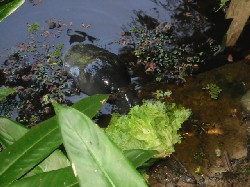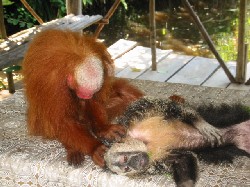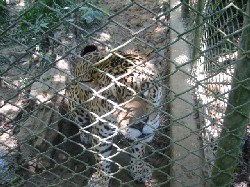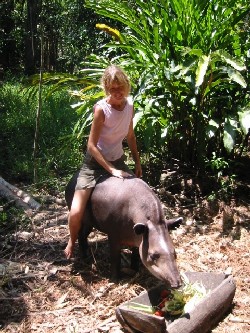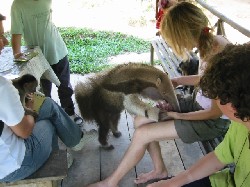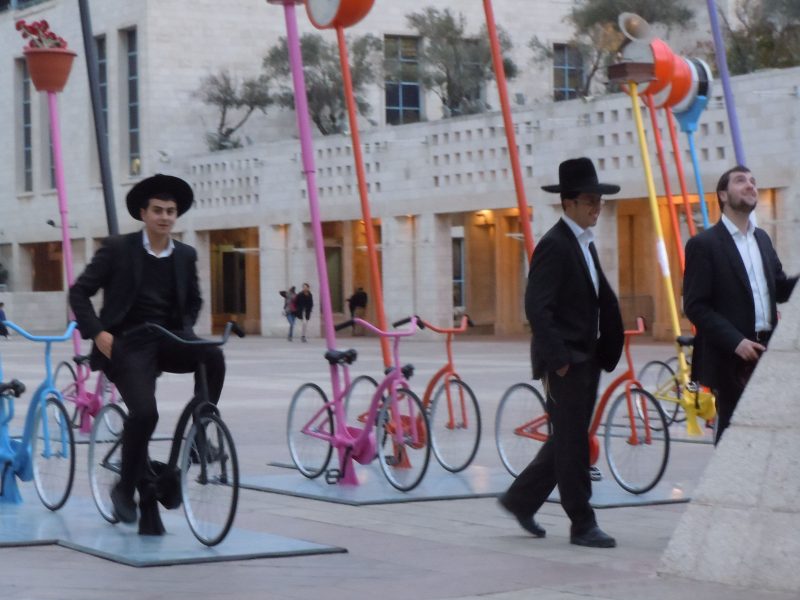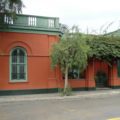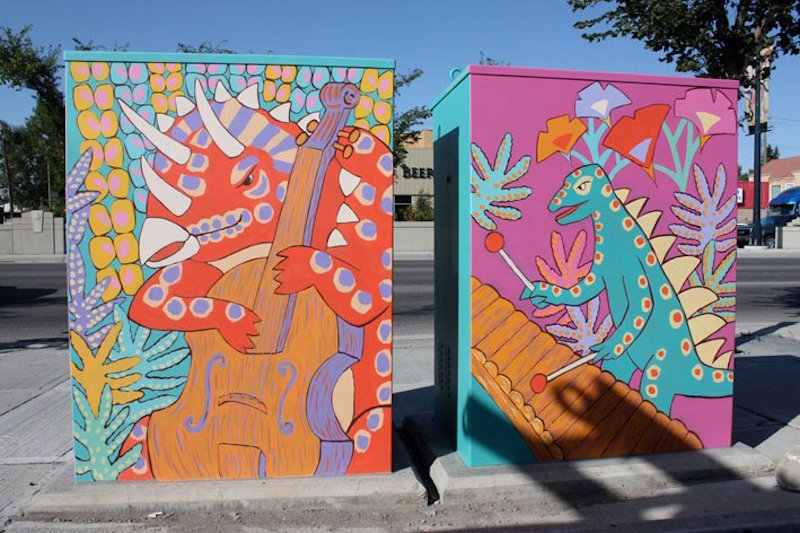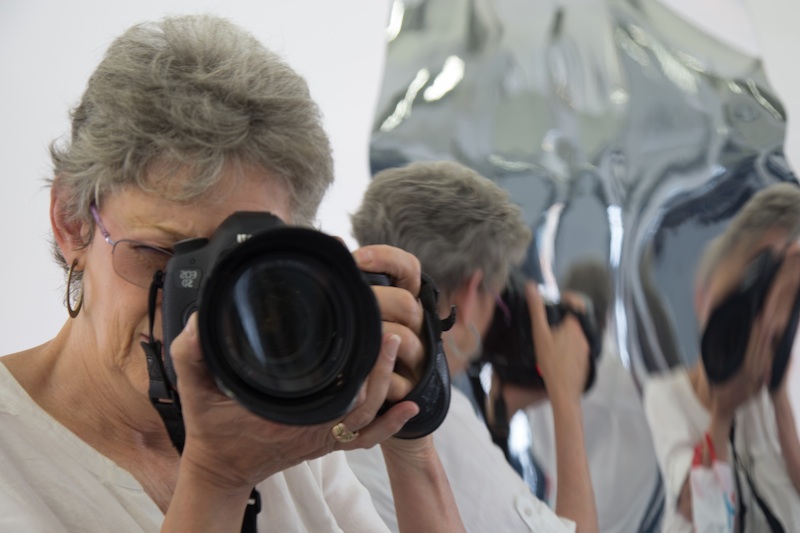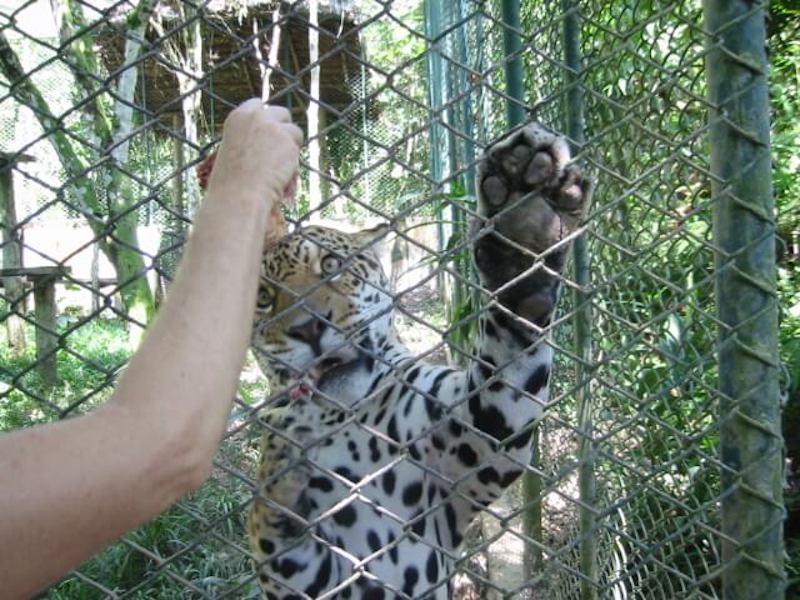
Claudiaexpat has written this article after visiting a Butterfly Sanctuary in the Peruvian Amazone.
If you happen to be or to go to Peru, and precisely in Iquitos, in the Amazon Basin, do not miss a visit to an incredible place on the Nanay River, where a lady who came a long time ago from Austria has set up a butterfly sanctuary and a home for jungle animals in need.
 In Iquitos go to the Bellavista peer and from there take a boat either straight to the “mariposario” or to the village of Padrecocha, and then walk for about twenty minutes. You then arrive to a peaceful and hidden place that is called Pilpintuwasi (quechua for Butterfly Home). Gudrun awaits you there, and takes you to visit the place she started setting up in 1995 with her Peruvian partner Robler, and opened to the public in 2001. But mind you, you won’t be alone during the visit: a group of monkeys will follow your path, either hooked on Gudrun’s shoulders, or balancing themselves from tree to tree, or even sitting comfortably around your neck or in your arms. This nearness to animals was the first thing I loved about the place. This, and the passion of Gudrun for what she does, and her fight to save animals and to spread the message that the jungle and its fauna are in danger, and that men only can do something to actively help the situation.
In Iquitos go to the Bellavista peer and from there take a boat either straight to the “mariposario” or to the village of Padrecocha, and then walk for about twenty minutes. You then arrive to a peaceful and hidden place that is called Pilpintuwasi (quechua for Butterfly Home). Gudrun awaits you there, and takes you to visit the place she started setting up in 1995 with her Peruvian partner Robler, and opened to the public in 2001. But mind you, you won’t be alone during the visit: a group of monkeys will follow your path, either hooked on Gudrun’s shoulders, or balancing themselves from tree to tree, or even sitting comfortably around your neck or in your arms. This nearness to animals was the first thing I loved about the place. This, and the passion of Gudrun for what she does, and her fight to save animals and to spread the message that the jungle and its fauna are in danger, and that men only can do something to actively help the situation.
Gudrun came to Peru 22 years ago. She had completed her studies as a social worker, and settled down in the Peruvian jungle, in remote villages, to teach and to work in developing projects. People of the villages she lived in ate the jungle animals, which is understandable and all right, but what happened most of the time was that they killed the mothers, captured the babies and were then unable to take care of them properly. Knowing that Gudrun loved animals, they brought the babies to her, and she looked after them, helped them recovering, and set them free into the jungle again.
This was not, however, the reason that prompted Gudrun to set up a butterflies sanctuary. She had decided to stay on in the jungle and she definitely had taken a passion for nature and animals, and held the health of the jungle much at heart; the idea came to her during a holiday she was spending in Austria, when she was visiting the zoo and saw the butterflies section.
She loved butterflies and she then decided to build a sanctuary with the double purpose of showing people the life process of butterflies and to send Peruvian species to Europe. She started looking for caterpillars and breeding butterflies in 1995. She quickly realized that even if at that time regulations were easier than they are today, it was already impossible to export butterflies from Peru. The reason why she started working with tourism was first of all the need to get some income after having spent so much work and time in finding out how and where to breed the different species of butterflies.
She had bought the land on the Nanay river, and built her house and what was to become a shelter for many endangered jungle animals. Indeed, the routine of delivering sick animals to Gudrun resumed almost immediately: she was called for assistance from veterinaries that could not host wounded or sick animals, orphans whose mothers had been killed by hunters, or animals that are sold to people that cannot properly take care of them.
So, what you actually see today is a beautiful and calm place where butterflies reproduce themselves but also where needy animals are bred, taken care of, loved.
The tour starts by giving fresh salad to a manatee, hosted in a natural pond next to the reception area of Pilpintuwasi. Gudrun tells us that she had refused to buy the animal – she sometimes must put a stop to a flow that could easily become uncontrollable….. -, but considering that manatee is a much endangered species and that the person who was selling it would have slaughtered it hadn’t he found him a house, she finally accepted.
You continue your visit accompanied by a cheerful and loving group: Chavo is a Red Uakari monkey, an endangered species found in the Amazon forests only, and arrived to Pilpintuwasi hardly malnourished and with a fractured foot, due to a fall when his mother was shot. You then have Florian and Zecke, two Saki monkeys, both on the verge of dying of malnutrition when they arrived to Pilpintuwasi, and that now go up and down the trees and yourself incessantly. You then have the more recent acquisition, Tony, a Capuchin monkey that used to live with street children. When he got sick one day a tourist pitied him seeing that he was almost unable to hang on to a little boy’s neck. The guy noticed that the animal was sick, and so he gave the children some money (though he shouldn’t have done that!!!) and left the animal at Pilpintuwasi. Tony had a terrible diarrhea, so Gudrun took him to the vet, that took some analysis: the poor little monkey had three different kinds of parasites, but after the treatment he started developing very well again. A curious thing about Tony is that he seems to have been trained to steal already: when people with earrings arrive at Pilpintuwasi, Tony gets on them immediately and takes away their earrings, he perfectly knows how to open the common ones.
The tour starts with the butterflies, while Gudrun explains you in detail how their cycle goes. She has 43 species, some of them of amazing beauty.
After the butterflies you find yourself in front of a totally different presence: Pedro Bello (Pedro the Beautiful). He’s a beautiful, magnificent jaguar that a man bought from local people with the idea to sell it in Iquitos. He tried to do so during a month (without taking care of feeding the poor animal) and then left him in Pilpintuwasi. It is charming to listen to Gudrun telling the story of Pedro and how he got to her place in a cage. Pedro eats 4 kilos of meat per day, 40% of which must be red meat. A huge expense for Pilpintuwasi, whose only financial sources are the entrance fees of visitors and the salary of Gudrun, that teaches English and German at the university in Iquitos.
You then arrive to Lolita, a lovely tapir whose story is also very sad: people that killed her mother tried to raise Lolita. In order to avoid that she runs away, they tied her paws with a nylon string. When the animal got to the point of being unable to stand because of the wounds the nylon had inflicted upon her, the “owner” offered her to Pilpintuwasi. Lolita is vegetarian, and it is a real joy to see her eating her huge papaya after Gudrun has climbed on her big back.
Time to go back to the reception area, while chatting with Gudrun about a variety of subjects.
Maintaining something like Pilpintuwasi is not easy. Funding is scarce, and the need is enormous. Gudrun and Roble cannot afford to employ many people to help them in the management of the place, so they do most of what’s needed by themselves. From time to time they take volunteers in, but it does not always work out smoothly. Volunteers need to be trained, and many of them do not resist the heat and the harsh conditions of the jungle.
Gudrun set all this up out her pure love for animals and nature. What most matters to her is to educate local people to understand the importance of preserving their natural habitat. She actually realized the huge lack of knowledge about nature and decided to work with schools, kindergartens and universities. Pilpintuwasi promotes workshops and conferences with students, in schools and with the local population, with special emphasis on the young ones, to teach them about the richness their jungle has in terms of fauna, and how respecting it is the only way to ensure a healthy and long-lasting future to both the endangered species and consequently to the man itself.
It is really inspiring to see how Gudrun manages all this, and how happy the animals are with her. While we sit in the shade of the reception hut, and the monkeys explore our hair with incredible concentration, the anteater Rosa arrives: what an incredible amazing creature!!! She arrived to Pilpintuwasi with a student of Gudrun that realized that the people where he lived, and where Rosa was held, did not provide her with appropriate care. Rosa walks up to Gudrun and “hugs” her, putting her long muse into her legs and greedily accepting some patting and caressing. A young boy follows: he’s the one who is taking care of Rosa today, bringing her back home after a walk and giving her a bath. Gudrun tries to have boys and girls of the area taking care of the animals. It is the fastest and more natural way to approach the richness they are given for free.
I had a wonderful time with Gudrun at her Pilpintuwasi. I do not know whether I’ll be able to go back and visit her again before I leave Peru for good, but one thing is sure: if I go, I’ll pack as much lettuce as I can for the manatee: he needs 10 to 12 kilos per day, and he’s just one of the many hungry mouths that smile to Gudrun as she passes by in this amazing place she has created.

